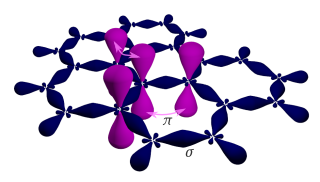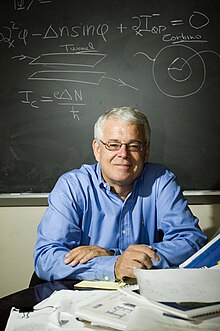
In physics, topological order is a kind of order in the zero-temperature phase of matter. Macroscopically, topological order is defined and described by robust ground state degeneracy and quantized non-abelian geometric phases of degenerate ground states. Microscopically, topological orders correspond to patterns of long-range quantum entanglement. States with different topological orders cannot change into each other without a phase transition.
Katsunori Wakabayashi is a physicist at the International Center for Materials Nanoarchitectonics (MANA), National Institute for Materials Science (NIMS), Japan. He is an authority and leading researcher in nanotechnology in the area of energy states of single wall carbon nanotubes (SWCN). His research is notable for the edge effects of the nanographene materials, which is a part of the single layer graphene. He obtained his Ph.D. in 2000 from University of Tsukuba in Japan. From 2000 to 2009 he was an assistant professor at Department of Quantum Matter in Hiroshima University, Japan. From 2009, he is an Independent Scientist at International Center for Materials Nanoarchitectonics (WPI-MANA), National Institute for Materials Science (NIMS) in Tsukuba, Japan. Beside the above primary research position, he was a visiting scholar at ETH-Zurich, Switzerland from 2003 to 2005, also had a concurrent position as PRESTO researcher in Japan Science and Technology Agency (JST).

Nicholas Harrison FRSC FinstP is an English theoretical physicist known for his work on developing theory and computational methods for discovering and optimising advanced materials. He is the Professor of Computational Materials Science in the Department of Chemistry at Imperial College London where he is co-director of the Institute of Molecular Science and Engineering.
In physics, the plasmaron was proposed by Lundqvist in 1967 as a quasiparticle arising in a system that has strong plasmon-electron interactions. In the original work, the plasmaron was proposed to describe a secondary peak in the photoemission spectral function of the electron gas. More precisely it was defined as an additional zero of the quasi-particle equation . The same authors pointed out, in a subsequent work, that this extra solution might be an artifact of the used approximations:
We want to stress again that the discussion we have given of the one-electron spectrum is based on the assumption that vertex corrections are small. As discussed in the next section recent work by Langreth [29] shows that vertex corrections in the core electron problem can have a quite large effect on the form of satellite structures, while their effect on the quasi particle properties seems to be small. Preliminary investigations by one of us (L.H.) show similar strong vertex effects on the conduction band satellite. The details of the plasmaron structure should thus not be taken very seriously.
Bilayer graphene is a material consisting of two layers of graphene. One of the first reports of bilayer graphene was in the seminal 2004 Science paper by Geim and colleagues, in which they described devices "which contained just one, two, or three atomic layers"
James P. Eisenstein is an American physicist noted for his experimental research on strongly interacting two-dimensional electron systems. He is currently the Frank J. Roshek Professor of Physics and Applied Physics, Emeritus, at the California Institute of Technology.
Eva Yocheved Andrei is an American condensed matter physicist, a Distinguished Professor, and a Board of Governors Professor at Rutgers University. Her research focuses on emergent properties of matter arising from the collective behavior of many particles, especially low-dimensional phenomena under low temperatures and high magnetic fields.

Graphene is a semimetal whose conduction and valence bands meet at the Dirac points, which are six locations in momentum space, the vertices of its hexagonal Brillouin zone, divided into two non-equivalent sets of three points. The two sets are labeled K and K′. The sets give graphene a valley degeneracy of gv = 2. By contrast, for traditional semiconductors the primary point of interest is generally Γ, where momentum is zero. Four electronic properties separate it from other condensed matter systems.

Single-layer graphene was first unambiguously produced and identified in 2004, by the group of Andre Geim and Konstantin Novoselov, though they credit Hanns-Peter Boehm and his co-workers for the experimental discovery of graphene in 1962; while it had been explored theoretically by P. R. Wallace in 1947. Boehm et al. introduced the term graphene in 1986.

Twistronics is the study of how the angle between layers of two-dimensional materials can change their electrical properties. Materials such as bilayer graphene have been shown to have vastly different electronic behavior, ranging from non-conductive to superconductive, that depends sensitively on the angle between the layers. The term was first introduced by the research group of Efthimios Kaxiras at Harvard University in their theoretical treatment of graphene superlattices.
Photonic topological insulators are artificial electromagnetic materials that support topologically non-trivial, unidirectional states of light. Photonic topological phases are classical electromagnetic wave analogues of electronic topological phases studied in condensed matter physics. Similar to their electronic counterparts, they, can provide robust unidirectional channels for light propagation. The field that studies these phases of light is referred to as topological photonics.

Pablo Jarillo-Herrero is a Spanish physicist and current Cecil and Ida Green Professor of Physics at Massachusetts Institute of Technology (MIT).

Antonio Helio de Castro Neto, often referred to as the 'Godfather of Graphene,' is a Brazilian-born physicist who serves as the founder and director of the Centre for Advanced 2D Materials and as Co-Director of the Institute for Functional Intelligent Materials (IFIM) at the National University of Singapore. He is a condensed matter theorist known for his work in the theory of metals, magnets, superconductors, graphene and two-dimensional materials. He is a distinguished professor in the Departments of Materials Science Engineering, and Physics and a professor at the Department of Electrical and Computer Engineering. He was elected as a fellow of the American Physical Society in 2003. In 2011 he was elected as a fellow of the American Association for the Advancement of Science.

David Tománek (born July 1954) is a U.S.-Swiss physicist of Czech origin and researcher in nanoscience and nanotechnology. He is Emeritus Professor of Physics at Michigan State University. He is known for predicting the structure and calculating properties of surfaces, atomic clusters including the C60 buckminsterfullerene, nanotubes, nanowires and nanohelices, graphene, and two-dimensional materials including phosphorene.
Rafi Bistritzer is an Israeli physicist, and manager of an algorithms group at Applied Materials. He is the winner of the 2020 Wolf Prize in Physics, together with Pablo Jarillo-Herrero and Allan MacDonald, for "pioneering theoretical and experimental work on twisted bilayer graphene."
The term heterostrain was proposed in 2018 in the context of materials science to simplify the designation of possible strain situations in van der Waals heterostructures where two two-dimensional materials are stacked on top of each other. These layers can experience the same deformation (homostrain) or different deformations (heterostrain). In addition to twist, heterostrain can have important consequences on the electronic and optical properties of the resulting structure. As such, the control of heterostrain is emerging as a sub-field of straintronics in which the properties of 2D materials are controlled by strain. Recent works have reported a deterministic control of heterostrain by sample processing or with the tip of an AFM of particular interest in twisted heterostructures. Heterostrain alone has also been identified as a parameter to tune the electronic properties of van der Waals structures as for example in twisted graphene layers with biaxial heterostrain.
A Josephson diode (JD) is a special type of Josephson junction (JJ), which conducts (super)current in one direction better that in the opposite direction. In other words it has asymmetric current-voltage characteristic. Since Josephson diode is a superconducting device, the asymmetry of the supercurrent transport is the main focus of attention. Opposite to conventional Josephson junctions, the critical (maximum) supercurrents and for opposite bias directions are different by absolute values. In the presence of such a non-reciprocity, the bias currents of any magnitude in the range between and can flow without resistance in only one direction.

Sung Ryul Eric Yang is a theoretical condensed matter physicist. He is a full professor in the Department of Physics of Korea University.
Fractional Chern insulators (FCIs) are lattice generalizations of the fractional quantum Hall effect that have been studied theoretically since 1993 and have been studied more intensely since early 2010. They were first predicted to exist in topological flat bands carrying Chern numbers. They can appear in topologically non-trivial band structures even in the absence of the large magnetic fields needed for the fractional quantum Hall effect. In principle, they can also occur in partially filled bands with trivial band structures if the inter-electron interaction is unusual. They promise physical realizations at lower magnetic fields, higher temperatures, and with shorter characteristic length scales compared to their continuum counterparts. FCIs were initially studied by adding electron-electron interactions to a fractionally filled Chern insulator, in one-body models where the Chern band is quasi-flat, at zero magnetic field. The FCIs exhibit a fractional quantized Hall conductance.
Leo Radzihovsky is a Russian American condensed matter physicist and academic serving as a professor of Distinction in Physics at the University of Colorado Boulder.









